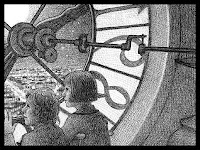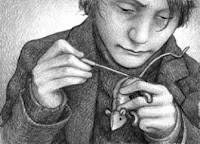The Invention of Hugo Cabret was awarded the 2008 Caldecott Medal, and was the first non-picture book (in the traditional sense) to win this honor. The story is told in over 500 pages of pictures and words, with 284 pages of Selznick’s trademark monochromatic pencil sketches framed in black.

Hugo Cabret is an orphan who lives in a secret room in the clock tower of a train station in Paris. Because he is neglected (and eventually deserted) by his uncle, the timekeeper at the train station, Hugo learns to steal to survive, and takes over the task of winding the clocks at the station.
 Compared to The Houdini Box, the illustrations are rougher and darker in Hugo Cabret, but serve well in establishing the cinema noir feel of the story and still showcase Selznick’s mastery of light and darkness. I love how Selznick’s illustrations zoom in and out on the details, and how each drawing leads into another, drawing excitement with each turn of the page, especially during the chase sequences, and when clues to the puzzle are revealed.
Compared to The Houdini Box, the illustrations are rougher and darker in Hugo Cabret, but serve well in establishing the cinema noir feel of the story and still showcase Selznick’s mastery of light and darkness. I love how Selznick’s illustrations zoom in and out on the details, and how each drawing leads into another, drawing excitement with each turn of the page, especially during the chase sequences, and when clues to the puzzle are revealed.I am sad, though, that I read this book after The Arrival, because had I read Hugo Cabret first, I would have enjoyed the book more . Since the book is hugely plot-driven, I felt it was a bit lacking in depth and character development; a bit more introspection from Hugo’s character would have placed the two books on a more even plane.

Despite that small sentiment on my part, I still give full marks for the book for breaking new ground in books for young readers, especially in illustrated novels. Selznick is definitely in the hall of fame in my bookshelf, and I look forward to collecting more of his works.
 ***
***
My copy: hardcover
My rating 5/5



